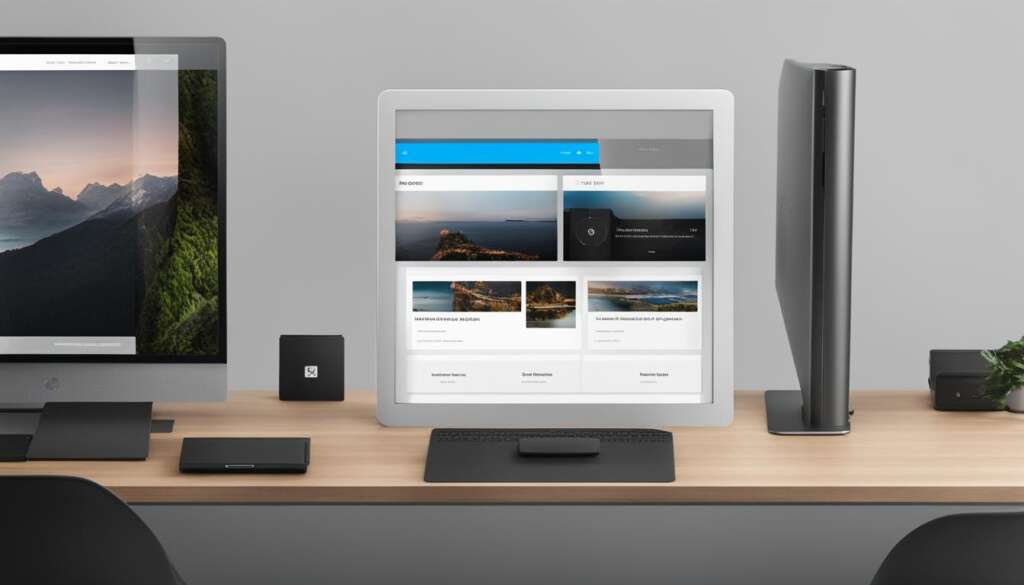Table of Contents
Navigation is an essential aspect of user experience in web design, particularly in responsive designs that adapt to various screen sizes. This article provides expert strategies for responsive navigation that simplify the user experience on every device, contributing to an optimal web design. By analyzing content types, selecting the appropriate navigation menu, and designing efficient navigation interactions, designers can create a seamless and intuitive navigation experience for users, ultimately enhancing the overall user experience.
Navigation plays a crucial role in shaping the user experience of a website. It acts as a pathway for users to access the content they are looking for. While content is the heart of a website, navigation serves as the bridge that connects users to that content. It is important to strike a balance between unique and exciting content, and simple and predictable navigation.
Users have differing expectations when it comes to content and navigation. Some users may prefer a visually appealing design with innovative navigation techniques, while others may prefer a more traditional and straightforward approach. Designers must understand these contrasting expectations and find a middle ground that satisfies the majority of users.
In this article, we will delve into the significance of effectively structuring content and explaining navigational choices to enhance the overall user experience. By doing so, designers can ensure that users can seamlessly navigate through a website to find the desired content.
Let’s begin by exploring the importance of structuring content effectively.
Properly structuring website content is essential for simplifying navigation. When designing a website, it is crucial for designers to consider how users look for information and categorize items based on relevant meta data. By creating distinct meta data categories, such as “course,” “main ingredient,” or “occasion,” users can easily browse and find the content they are looking for.
However, it is important for designers to carefully select and present these categories to avoid overwhelming users and ensure a smooth navigation experience. Too many categories can confuse users and make it difficult for them to find what they are looking for, while too few categories can lead to a lack of organization and make it challenging to navigate the website effectively.
By using a thoughtful and strategic approach to structuring content, designers can create an intuitive information architecture that enhances navigation. A well-structured website improves user experience by providing clear pathways to desired content and allowing for efficient browsing and exploration.
“A well-structured website improves user experience by providing clear pathways to desired content and allowing for efficient browsing and exploration.”
One effective way to structure content is by using hierarchical categories, with broader categories at the top and more specific subcategories below. This creates a logical hierarchy that helps users understand the organization of the content and find what they need more easily. For example, a recipe website might have categories such as “Main Course,” “Dessert,” and “Breakfast,” with further subcategories like “Chicken,” “Chocolate,” and “Eggs.”
Another helpful technique is to incorporate filters and search functionality. This allows users to refine their navigation based on specific criteria, such as dietary preferences, cooking time, or difficulty level. Filters and search can greatly enhance the user experience, as they empower users to quickly find exactly what they are looking for without having to browse through multiple categories.
Strategically organizing content and implementing user-friendly navigation menus can significantly improve the overall user experience on a website. By making content easily discoverable and accessible, designers can ensure that users can navigate the site effortlessly, leading to increased engagement and satisfaction.
Example of Structured Content
| Category | Subcategory | Example Content |
|---|---|---|
| Main Course | Soups | Tomato Soup |
| Main Course | Pasta | Spaghetti Bolognese |
| Main Course | Chicken | Lemon Herb Roasted Chicken |
| Dessert | Cakes | Chocolate Fudge Cake |
| Dessert | Cookies | Chocolate Chip Cookies |
| Breakfast | Eggs | Scrambled Eggs |
Once the content is properly structured, designers need to consider the right type of navigation menu that best suits their website’s needs. This decision requires a careful assessment of user preferences, the website’s purpose, and the volume of content.
Various navigation menu options are available, each with its own strengths and considerations:
- Drop-down menus: These menus allow for compact navigation by presenting submenus when users hover or click on the main menu. They are suitable for websites with a hierarchical structure and multiple subpages.
- Hamburger menus: These iconic three-lined menus are commonly used for mobile devices to save space. When clicked or tapped, they reveal a hidden menu with navigation options.
- Dot navigation: This type of menu uses dots or small circles to represent different pages or sections of a website. It is suitable for websites with few pages or sections, providing a visually appealing and minimalistic navigation experience.
Designers must carefully evaluate their target audience and the website’s content to determine the most appropriate navigation menu. A user-friendly and intuitive menu is crucial for ensuring the smooth navigation experience that aligns with user preferences.
Examples:
| Website Type | User Preferences | Recommended Navigation Menu |
|---|---|---|
| eCommerce | Easy access to product categories and filters | Drop-down menus |
| News | Quick access to different sections and articles | Hamburger menus |
| Portfolio | Showcasing a limited number of projects | Dot navigation |
Choosing the right navigation menu can significantly enhance the overall navigation experience for website visitors. By considering user preferences and the specific requirements of the website, designers can ensure seamless and intuitive navigation.
When designing navigation experiences, interaction design plays a vital role in ensuring efficiency and usability. Designers must consider various factors, such as symbols, target areas, interaction events, layout, levels, and functional context, to create seamless navigation experiences that meet user expectations.
One effective technique is the use of symbols to indicate different types of navigation interactions. For instance, adding downward triangles or plus signs can help distinguish drop-down menus from regular links, providing visual cues to users. These symbols not only enhance the overall aesthetic appeal but also ensure intuitive navigation.
The size and placement of target areas should also be carefully considered. Optimizing the target areas makes it easier for users to interact with navigation elements, reducing the chances of accidental clicks and improving the overall user experience. By placing target areas strategically, designers can enhance the usability of navigation interactions.
Consistency in design elements
Consistency in design elements is crucial in meeting user expectations and improving usability. When navigation interactions have a consistent layout, users can quickly learn and understand how to navigate through different sections of a website. Consistency breeds familiarity, and familiar elements facilitate a smooth navigation experience.
Keeping an eye on user expectations is vital while designing navigation interactions. Users have certain expectations based on their previous experiences with other websites, and meeting these expectations improves usability. For example, users instinctively know that clicking a logo will take them back to the homepage. By aligning navigation interactions with these expectations, designers can create a user-friendly interface.
In conclusion, by considering symbols, optimizing target areas, ensuring consistency, and meeting user expectations, designers can create efficient navigation interactions. These thoughtful design choices enhance the usability of websites, making it easier for users to navigate and find the information they need.
| Factors | Description |
|---|---|
| Symbols | Use symbols like downward triangles or plus signs to indicate drop-down menus and distinguish them from regular links |
| Target Areas | Optimize the size and placement of target areas to facilitate easy and accurate navigation interactions |
| Consistency | Maintain consistency in design elements to meet user expectations and improve usability |
| User Expectations | Design navigation interactions that align with user expectations based on their previous experiences |
Responsive navigation presents a unique set of challenges, particularly for websites with complex multi-level navigation structures. These challenges become even more pronounced on large websites that cater to diverse audiences and have various entry points. To ensure a seamless user experience and smooth navigation across all screen sizes, designers must address these challenges effectively.
One of the primary challenges in responsive navigation is organizing the multiple levels of navigation in a way that is intuitive and user-friendly. With a multitude of content and categories to navigate, finding a balance between simplicity and inclusiveness can be demanding. Designers must carefully curate the navigation systems to prioritize simplicity, intuitiveness, consistency, and meeting user expectations.
To overcome these challenges, designers can follow industry best practices and implement strategies that have proven to be effective. Prioritizing simplicity involves decluttering navigation menus and streamlined labels that clearly communicate the purpose of each category. Intuitiveness can be achieved through implementing familiar navigation patterns and symbols that users are already familiar with. Consistency across all screen sizes and devices ensures a cohesive user experience, allowing users to easily transition between different screens without confusion. Lastly, meeting user expectations involves understanding their browsing behaviors and implementing thoughtful design choices that align with their needs and preferences.
Below is a table summarizing the challenges posed by responsive navigation and the corresponding strategies to overcome them:
| Challenges | Strategies for Overcoming |
|---|---|
| Complex multi-level navigation | Streamline navigation menus, prioritize simplicity, and ensure intuitive categorization |
| Diverse audiences and entry points | Implement navigation systems that cater to different user groups and provide easy access to key content |
| Ensuring consistency across screens | Create responsive designs that maintain a consistent navigation experience across different devices |
| Meeting user expectations | Conduct user research, understand their needs, and implement design choices that align with their preferences |
By addressing these challenges head-on and implementing responsive navigation strategies, designers can create websites that provide an optimal user experience on all devices and screen sizes. The seamless and intuitive navigation experience will contribute to increased user engagement and satisfaction.
Next, we will delve into the details of designing effective responsive navigation strategies that align with information architecture and user goals.
When it comes to responsive web design, creating an effective navigation system is crucial for enhancing user engagement and satisfaction. Designing responsive navigation strategies requires careful consideration of information architecture from a mobile perspective, ensuring that users can easily navigate and access the desired content on any screen size. Here are a few key strategies to optimize responsive navigation:
Responsive websites often have limited screen space, making it essential to simplify navigation structures. By reducing the number of menu items and using hierarchical navigation structures, designers can streamline the user experience and prevent overwhelming users with an abundance of options.
Prioritize Key Pages
Understand user goals and prioritize key pages accordingly. Identify the most important pages that align with user goals and make them easily accessible through clear and prominent navigation elements. By placing key pages within a few taps or clicks, users can quickly find the information they seek, improving navigation efficiency.
Eliminate Unnecessary Content
Optimize navigation by eliminating unnecessary content that may distract or confuse users. Conduct regular content audits to identify and remove outdated or redundant pages from the navigation menu. A streamlined navigation structure with relevant content keeps users focused and enhances the overall user experience.
Include Familiar UI Components
Incorporate familiar user interface (UI) components, such as hamburger menus and breadcrumb navigation, to enhance usability. Hamburger menus provide a compact and collapsible navigation menu, while breadcrumb navigation helps users understand their current location within a website. By leveraging these familiar UI components, designers can create intuitive and user-friendly responsive navigation.
Remember, the goal of designing responsive navigation strategies is to create an information architecture that aligns with user goals, simplifies navigation structures, and ensures a seamless user experience across all devices. By implementing these strategies, designers can optimize responsive navigation and improve overall user engagement.
| Design Strategy | Description |
|---|---|
| Simplify Navigation Structures | Reduce the number of menu items and use hierarchical navigation structures to streamline the user experience. |
| Prioritize Key Pages | Identify and prioritize key pages that align with user goals to ensure easy access and quick navigation. |
| Eliminate Unnecessary Content | Regularly conduct content audits and remove outdated or redundant pages from the navigation menu. |
| Include Familiar UI Components | Incorporate familiar UI components like hamburger menus and breadcrumb navigation to enhance usability. |
Conclusion
Responsive navigation is a crucial aspect of web design that significantly impacts the user experience on various devices. By carefully considering the challenges, implementing effective strategies, and following best practices, designers can create responsive navigation that provides a seamless and intuitive browsing experience for users.
To enhance user experience, it is essential to simplify the navigation structure, making it easy for users to find and access the information they need. By keeping the navigation intuitive and consistent, users can navigate the website effortlessly, regardless of the screen size they are using.
Meeting user expectations is also important for optimal user experience. By understanding how users interact with websites, designers can ensure that the navigation elements align with their expectations and behavior. By integrating responsive navigation into the overall web design, designers can create websites that deliver an exceptional user experience.
In conclusion, by prioritizing responsive navigation, considering user experience, and implementing effective web design practices, designers can create websites that are user-friendly, accessible, and responsive across all devices. By continuously evaluating and refining the navigation experience, designers can ensure that users can easily navigate their websites and find the information they need, resulting in a positive user experience and increased engagement.
FAQ
Navigation is an essential aspect of user experience in web design, especially in responsive designs that need to adapt to various screen sizes. It plays a vital role in ensuring that users can easily access the content they desire.
Content should be unique and exciting, while navigation should be simple and predictable. Designers need to find a balance between users’ expectations about content and navigation to enhance the overall user experience.
Properly structuring website content allows users to easily browse and find the information they are looking for. By categorizing items based on relevant meta data, such as “course,” “main ingredient,” or “occasion,” designers can create a seamless navigation experience.
Designers should consider factors such as user preferences, the website’s purpose, and the volume of content when choosing a navigation menu. Various options, including drop-down menus, hamburger menus, and dot navigation, can be used.
Designers should consider factors such as symbols, target areas, interaction events, layout, levels, and functional context. Symbols can be used to indicate drop-down menus, target areas should be optimized for easy navigation, and consistency in design elements improves usability.
Responsive navigation can be particularly challenging for complex websites with multiple levels of navigation. Large websites with diverse audiences and different entry points require careful organization and intuitive navigation systems.
By prioritizing simplicity, intuitiveness, consistency, and meeting user expectations, designers can overcome the challenges in responsive navigation. This ensures a seamless navigation experience across all screen sizes.
Designers should consider information architecture from a mobile perspective, simplifying navigation structures, prioritizing key pages, and eliminating unnecessary content. Including familiar UI components, such as hamburger menus and breadcrumb navigation, can further improve usability.
Responsive navigation enhances the user experience by providing a seamless and intuitive experience for users across different devices. Following best practices in responsive navigation design ensures that users can easily navigate websites, regardless of the screen size.













